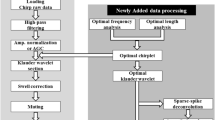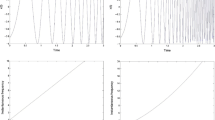Abstract
Chirp technology is an acoustic tool for imaging the shallow seabed with a high resolution, used for investigations of modern to Quaternary sedimentary structures and processes and more applied goals, such as hazard surveys for drilling, archeology, geology or engineering fields. In this paper, we present new methods that improve such imaging. During the standard acquisition, the Chirp waveforms are converted into analytic signals and only their envelope is preserved and interpreted, because the highly oscillating signal is otherwise difficult to be identified visually. Doing so, however, the phase information is lost, and the final processing is limited mainly to simple time-varying gain recovery or filtering. We present a work flow including a derivative step to transform the enveloped signal into a seismic-like waveform. In this way, we can apply processing tools as FX deconvolution and migration to improve the signal/noise ratio and reduce diffractions. This method allows reviving standard and legacy Chirp data where the full-waveform information is missing.











Similar content being viewed by others
References
Aiello G, Di Fiore V, Marsella E, Passaro S (2014) High resolution seismic data coupled to Multibeam bathymetry of Stromboli island collected in the frame of the Stromboli geophysical experiment: implications with the marine geophysics and volcanology of the Aeolian Arc volcanic complex (Sicily, Southern Tyrrhenian Sea, Italy). Springerplus 3:232
Baradello L (2014) An improved processing sequence for uncorrelated Chirp sonar data. Marine Geophys Res 35(4):337–344
Civile D, Lodolo E, Caffau M, Baradello L, Ben-Avraham Z (2016) Anatomy of a submerged archipelago in the Sicilian Channel (central Mediterranean Sea). Geol Mag 153:160–178
Cristini P, Le Touzé G, Favretto-Cristini N (2010). Envelope of signal and bandwidth: the key parameters for vertical seismic resolution. Société Française d'Acoustique - SFA. 10ème Congrès Français d'Acoustique, Lyon, France
Donda F, Brancolini G, Tosi L, Kovačević V, Baradello L, Gačić M, Rizzetto F (2008) The ebb-tidal delta of the Venice Lagoon. Italy the Holocene 18(2):267–278. https://doi.org/10.1177/0959683607086765
Ercilla G, Cordoba D, Gallart J, Gracia E, Munoz JA, Somoza L, Vazquez JT, Vilas F, Prestige Group (2006) Geological characterization of the Prestige sinking. Marine Pollut Bull 53:208–219
Gholamy A, Kreinovich V (2014) Why Ricker wavelets are successful in processing seismic data: Towards a theoretical explanation. In: IEEE symposium on computational intelligence for engineering solutions (CIES). IEEE, 11–16. https://doi.org/10.1109/CIES.2014.7011824
Gutowski M, Bull J, Henstock T, Dix JK, Hogarth P, Leighton T, White P (2002) Chirp sub-bottom profiler source signature design and field testing. Mar Geophys Res 23:481–492
Henkart P (2006) Chirp Sub-Bottom profiler processing – a review. Sea Technol 47(10):35–38
Hornbach MJ, Mann P, Frohlich C, Ellins K, Brown L (2011) Assessing geohazards near Kingston, Jamaica: initial results from Chirp profiling. Lead Edge 30(4):410–413
Hutchinson DR, Detrick RS (1984) Water gun vs air gun: A comparison. Mar Geophys Res 6(3):295–310. https://doi.org/10.1007/bf00286531
Kim HJ, Chang JK, Jou HT, Park GT, Suk BC, Kim GY (2002) Seabed classification from acoustic profiling data using the similarity index. J Acoust Soc Am 111:794–799
Kluesner J, Brothers D, Hart P, Miller N, Hatcher G (2019) Practical approaches to maximizing the resolution of sparker seismic reflection data. Mar Geophys Res 40:279–301. https://doi.org/10.1007/s11001-018-9367-2
Lodolo E, Baradello L, Darbo A, Caffau M, Tassone A, Lippai H, Lodolo A, De Zorzi G, Grossi M (2012) Occurrence of shallow gas in the easternmost Lago Fagnano (Tierra del Fuego). Near Surface Geophysics 10:161–169. https://doi.org/10.3997/1873-0604.2011040
Maa JP-Y, Lee D-Y (2002) A preliminary study on using acoustic waves to measure high resolution marine sediment bed structure. In: Winterwerp JC, Kranenburg C (eds) Fine-sediment dynamics in the marine environment. Elsevier, Amsterdam, 469–481, ISBN 9780444511362. https://doi.org/10.1016/s1568-2692(02)80034-1
Missiaen T, Murphy S, Loncke L, Henriet JP (2002) Very high-resolution seismic mapping of shallow gas in the Belgian coastal zone. Cont Shelf Res 22(16):2291–2301
Panda S, LeBlanc LR, Schock SG (1994) Sediment classification based on impedance and attenuation estimation. Journal Acoustic Soc Am 96:3022–3035
Plets RMK, Dix JK, Best AI (2008) Mapping of the buried yarmouth roads wreck, isle of Wight, UK, using a Chirp sub-bottom profiler. Int J Naut Archaeol 37(2):360–373
Quinn R, Bull JM, Dix JK (1997) Imaging wooden artefacts using Chirp sources. Archaeol Prospect 4(1):25–35
Quinn R, Bull JM, Dix JK (1998) Optimal processing of marine high resolution seismic reflection (Chirp) data. Marine Geophys Res 20:13–20
Ricker N (1953) The form and laws of propagation of seismic wavelets. Geophysics 18:10–40
Robinson EA (1981) Predictive Deconvolution. In: Fitch AA (eds) Developments in geophysical exploration methods. The developments series. Springer, Dordrecht. https://doi.org/10.1007/978-94-009-8105-8_4
Schock SG, LeBlanc LR, Mayer LA (1989) Chirp sub-bottom profiler for quantitative sediments analysis. Geophysics 54:445–450
Taner MT, Koehler F, Sheriff RE (1979) Complex seismic trace analysis. Geophysics 44:1041–1063
Yilmaz O (2010) Seismic data analysis. Investigation in geophysics n.10, society of exploration geophysicists, Tulsa (USA)
Acknowledgements
This work has been carried out and partially funded by the italian Programma Nazionale di Ricerche in Antartide PNRA18_00100 EDISTHO, PNRA16_00016 WHISPERS and PNRA ANTIPODE projects. The authors are grateful also to the Project PNRA GLEVORS (P.I. Chiara Sauli) for giving us permission to use the sub bottom-reflection profiles, and the crew and the scientific party onboard R/V OGS Explora 2017 expedition for collecting the data investigated in this paper. We used the Echos Paradigm software and the Kingdom Suite software so we thank IHS Markit Global Sàrl Educational Grant Program for providing to OGS a free license for the use of the complete package interpretation software, for educational and research purposes. Thanks to Laura de Santis for providing comments to improving the manuscript.
Author information
Authors and Affiliations
Corresponding author
Additional information
Publisher's Note
Springer Nature remains neutral with regard to jurisdictional claims in published maps and institutional affiliations.
Rights and permissions
About this article
Cite this article
Baradello, L., Battaglia, F. & Vesnaver, A. Fast method to transform chirp envelope data into pseudo-seismic data. Mar Geophys Res 42, 14 (2021). https://doi.org/10.1007/s11001-021-09436-y
Received:
Accepted:
Published:
DOI: https://doi.org/10.1007/s11001-021-09436-y




